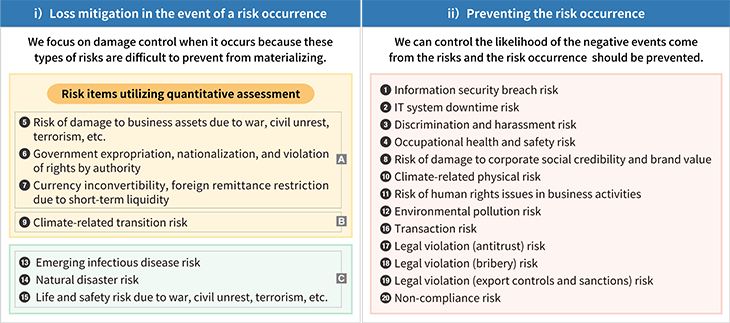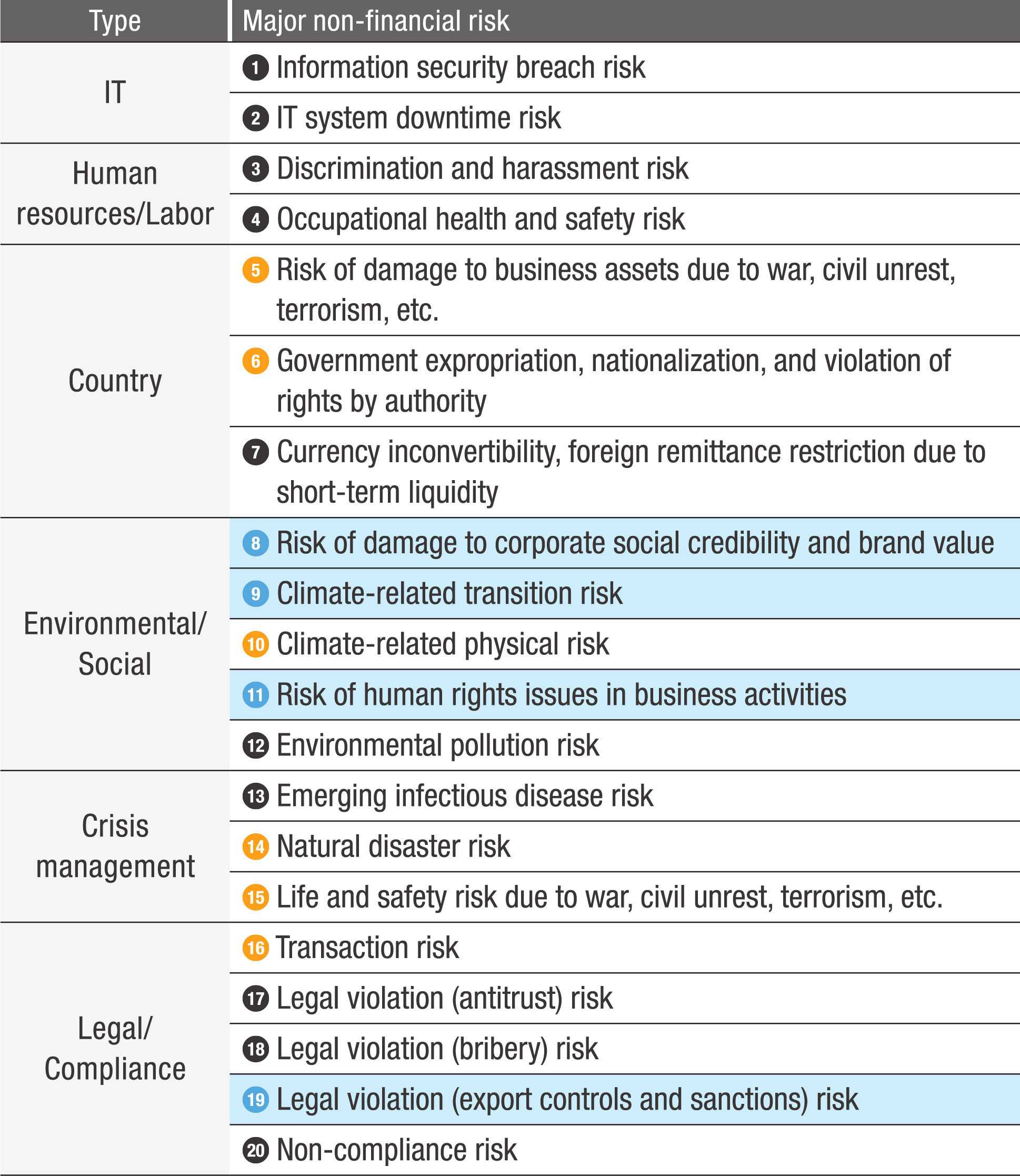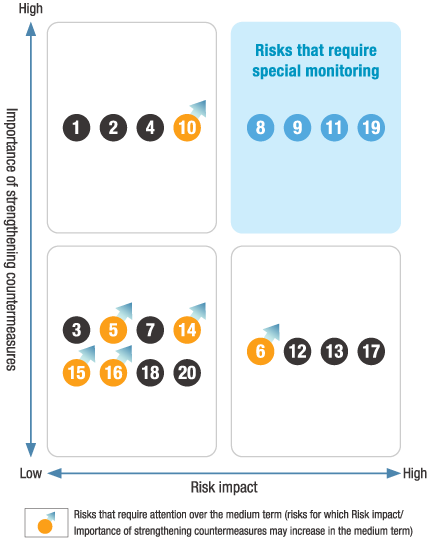Risk Management : Integrated Risk Management and Monitoring
Integrated Risk Management and Monitoring
MC implements integrated risk management and monitoring in addition to responding to risks individually. As an example, we identify operational risks, which have become increasingly important in recent years. Every year, we report our evaluation of these risks to the Board of Directors, which is based on unified standards, as well as on the establishment and operation of risk management systems, taking into account future changes in the external environment. In the fiscal year ended March 31, 2024, we conducted the following three-step evaluation and reported the results to the Board of Directors.
STEP1 Evaluation of the current situation by developing a risk map
MC identifies the major operational risks in the Company and then evaluates the risks on a consolidated basis in accordance with unified standards, before listing them as a risk map as follows. We identify “Risks that require special monitoring” (located in the upper right hand corner of the risk map), and the Board of Directors monitors the countermeasures.
STEP2 Medium-term evaluation taking into account the external environment
In addition to evaluating the current situation (Step 1), MC identifies external environmental factors (geopolitics, economics, the environment, etc.) that may affect major operational risks in order to take into account changes in the external environment over the medium-term. We identify operational risks that are particularly susceptible to such factors as “Risks that require attention over the medium term” since they may shift to “Risks that require special monitoring” in the future (see 5 , 6 , 10 , 14 , 15,and 16 below).
STEP3 Addressing risks that require attention over the medium term
In addition to “Risks that require special monitoring,” MC also positions “Risks that require attention over the medium term” as risks for which we should especially strengthen our responses in the future. We arrange the countermeasures for these risks as follows, and the Board of Directors monitors them.
- ⑤Risk of damage to business assets due to war, civil unrest, terrorism, etc.
- ⑥Government expropriation, nationalization, and violation of rights by authority
Responding to geopolitical uncertainties, we conducted the Global Intelligence Committee based on information gathered from the global network. In addition, we have developed a country risk countermeasure system on a company-wide basis to cope with the deterioration of national financial discipline, particularly in emerging countries.
- ⑩Climate-related physical risk
For the two assets (metallurgical coal and copper) determined to have a high level of exposure to physical risks in the physical risk assessment (metallurgical coal and copper; see the Climate Change section for additional details), we check annually whether there are any updates to the current measures and future adaptation strategies already disclosed.
- ⑭Natural disaster risk
We have prepared initial response and BCP on a consolidated basis both in Japan and overseas*.
- ⑮Life and safety risk due to war, civil unrest, terrorism, etc.
We have built up a structure for securing the lives and safety of our employees on a consolidated basis both in Japan and overseas*.
- ⑯Transaction risk
We are preventing negative impacts come from the transaction risk by clarifying the contractual relationship and to mitigate the loss with the support of the legal department when we expose to the risk.
- *See the Crisis Management on a Consolidated Basis/Business Continuity Management (BCM) for additional details.
【TOPICS】Risk Management Policy
In the fiscal year ended March 31, 2024, MC determined the risk management policy for each risk and classified them into two categories described below. Among the risk items that is classified to (i), we identified the risk items for which quantitative assessment is to be strengthened and promoted.

- ⑤Risks of damage to business assets due to war, civil unrest, terrorism, etc.
- ⑥Government expropriation, nationalization, and violation of rights by authority
- ⑦Currency inconvertibility, foreign remittance restriction due to short-term liquidity
Based on the various risk factors of each country, we set ceilings of acceptable risk (Company-wide Management Framework) for each country and conducts a semi-annual survey to control the accumulation of risk.
- ⑨Climate-related transition risk
We have already set GHG emissions reduction targets and have disclosed Scope 1, 2, and Scope 3 Category 11 emissions as well as avoided emissions (See Key GHG Metrics and Disclosure Highlights for additional details). Based on these initiatives, in order to comply with sustainability disclosure standards, we are continuously considering and reviewing internally how best to quantify the financial impact of climate-related transition risk and the appropriate disclosure methods.
- ⑬Emerging infectious disease risk
- ⑭Natural disaster risk
- ⑮Life and safety risk due to war, civil unrest, terrorism, etc.
We are focused on building a system to mitigate loss in the event of a risk appeared.

